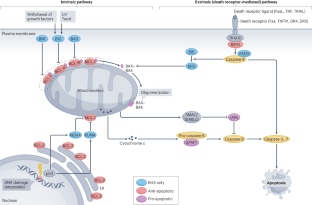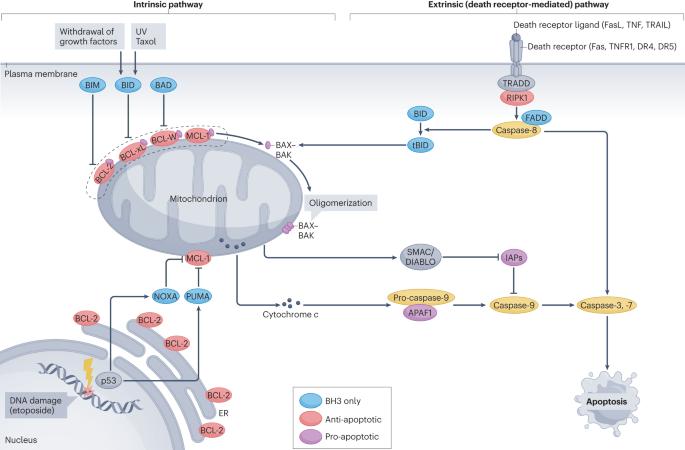细胞死亡途径指南
IF 81.3
1区 生物学
Q1 CELL BIOLOGY
引用次数: 0
摘要
由专用分子机器介导的有序细胞死亡在健康和疾病中发挥着重要作用。细胞凋亡、坏死和热凋亡是细胞程序性死亡的三种模式。半胱氨酸蛋白酶 Caspase 家族是细胞程序性死亡的关键调控因子。在细胞凋亡过程中,caspase 激活级联介导信号传导和细胞破坏,而热凋亡则是活化的 caspase 分解 gasdermins 时发生的,后者可在质膜上形成孔。坏死是由 RIPK3 和 MLKL 介导的一种不依赖于 Caspase 的程序性坏死,它被 Caspase-8 介导的 RIPK1 分裂所抑制。对细胞存活至关重要的细胞平衡机制(如正常的离子和氧化还原平衡以及溶酶体通量)受到破坏,也会在不启动细胞程序性坏死机制的情况下诱导细胞死亡。兴奋毒性、铁中毒和溶酶体细胞死亡就是这类细胞死亡模式的例子。在本综述中,我们将概述主要的细胞死亡机制,重点介绍对其复杂调控和执行的最新见解,以及它们与人类疾病的相关性。本文章由计算机程序翻译,如有差异,请以英文原文为准。


A guide to cell death pathways
Regulated cell death mediated by dedicated molecular machines, known as programmed cell death, plays important roles in health and disease. Apoptosis, necroptosis and pyroptosis are three such programmed cell death modalities. The caspase family of cysteine proteases serve as key regulators of programmed cell death. During apoptosis, a cascade of caspase activation mediates signal transduction and cellular destruction, whereas pyroptosis occurs when activated caspases cleave gasdermins, which can then form pores in the plasma membrane. Necroptosis, a form of caspase-independent programmed necrosis mediated by RIPK3 and MLKL, is inhibited by caspase-8-mediated cleavage of RIPK1. Disruption of cellular homeostatic mechanisms that are essential for cell survival, such as normal ionic and redox balance and lysosomal flux, can also induce cell death without invoking programmed cell death mechanisms. Excitotoxicity, ferroptosis and lysosomal cell death are examples of such cell death modes. In this Review, we provide an overview of the major cell death mechanisms, highlighting the latest insights into their complex regulation and execution, and their relevance to human diseases. Cell death can result from the activation of dedicated programmed cell death machineries or disruption of pro-survival mechanisms. This Review describes the different major mechanisms of cell death and discusses recent insights into their relevance to disease.
求助全文
通过发布文献求助,成功后即可免费获取论文全文。
去求助
来源期刊
CiteScore
173.60
自引率
0.50%
发文量
118
审稿时长
6-12 weeks
期刊介绍:
Nature Reviews Molecular Cell Biology is a prestigious journal that aims to be the primary source of reviews and commentaries for the scientific communities it serves. The journal strives to publish articles that are authoritative, accessible, and enriched with easily understandable figures, tables, and other display items. The goal is to provide an unparalleled service to authors, referees, and readers, and the journal works diligently to maximize the usefulness and impact of each article. Nature Reviews Molecular Cell Biology publishes a variety of article types, including Reviews, Perspectives, Comments, and Research Highlights, all of which are relevant to molecular and cell biologists. The journal's broad scope ensures that the articles it publishes reach the widest possible audience.

 求助内容:
求助内容: 应助结果提醒方式:
应助结果提醒方式:


